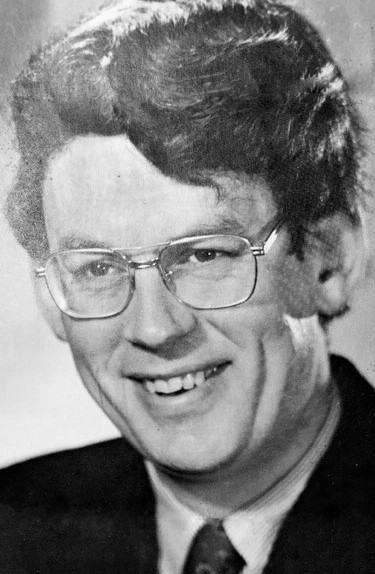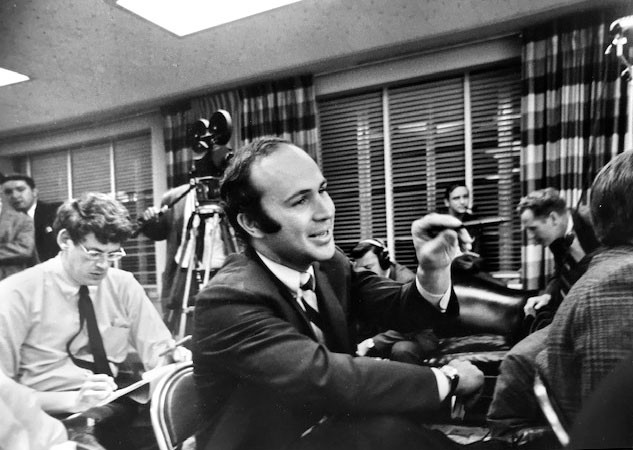First editor recalls Chronicle’s creation 50 years ago
By Arthur Brodeur
Arthur Brodeur ’58 was founding editor of the Cornell Chronicle; he is a former director of university relations and former speechwriter for Dale Corson, the university’s eighth president. He left Cornell in 1978 to become vice president for public affairs at Northeastern University.
The Chronicle was established in the wake of the Willard Straight Hall occupation on April 19, 1969. In a report on campus unrest by a specially formed board of trustees committee, the need for better communications “among all elements of the Cornell community” was evident during the occupation. Among the committee’s recommendations was establishment of a campus newspaper, which would serve to provide official university information not available through other media channels.
That was Brodeur’s charge; what follows is how he remembers the Chronicle’s earliest days.
Early in the morning of Sept. 25, 1969, Cornell University photographer Sol Goldberg and I sat on a roll of newsprint in the pressroom of The Ithaca Journal as Volume 1, Number 1 of the Cornell Chronicle came click-clacking off the press.
The launch of the Chronicle was a result of President Dale Corson implementing recommendations of the Report of the Special Trustee Committee on Campus Unrest at Cornell. The Cornell Chronicle was to be “the official weekly of record for Cornell University,” and I was to be its first editor. On Page 1 of the first issue, I wrote, “The Chronicle is an experimental venture at this stage.” That was a gross understatement: We were uncertain as to how long we/it would last.
We knew we were pioneers; there were only two other such newspapers in existence, the Harvard Gazette and, in Canada, the McGill Reporter. Today, most colleges and universities have newspapers, online and/or print, and it pleases this octogenarian communicator to see that even through technological evolution and sophistication, the Cornell Chronicle 50 years later still thrives and is dedicated to the communications principles and university goals that were the foundation of its creation.
I was given the honor of naming the new publication and, given my affection for alliteration, I came up with “Cornell Chronicle.” The name received approval at the upper administrative levels, so the masthead was born. I might have overdone the alliteration in the early days – with Barton Blotter, Chronicle Comment, Straight Scoop, Chronicle Capsule, etc.
We traveled a bumpy journalistic road at first. Typeface selection, press time and distribution were major issues. Since we were printed by The Ithaca Journal, which printed its own paper as well as The Cornell Daily Sun, we were limited as to typefaces available to us. We had to go with a light, sans serif type, which the Journal used in its advertising copy. Not ideal, but available. To complicate a sense of print unity, the faculty demanded that its material be in a typeface different from the rest of the paper; they wanted to get as close to New York Times typeface as possible. Accommodation was made and off we went.
Then there was the matter of when the Chronicle went on press. The Journal, then an afternoon paper, justifiably had priority, and the Sun, a morning paper, went on the press before we did. That was fine – except for the plethora of Sun staffers hovering around me as I worked with the layout guy to make up the paper. They were always trying to read copy to see if they were missing a scoop.
Distribution was a major early problem. The solution was to hire an Ithaca Journal circulation staffer, Macario “Gottie” Gessini, to drop piles of Chronicles at points throughout campus. Gottie got the Chronicle where it needed to be – most of the time; the custodians at the Law School kept throwing the bundles in the trash as soon as they hit the Myron Taylor loading dock. Their non-legal education took a while.
We had problems, but we had strengths. I was the sole university relations staffer assigned to the Chronicle, but all resources of the Cornell News Bureau were dedicated to the paper. And that meant the writing of some top-notch news people. We were all alumni of either the wire services (Associated Press, United Press International) or a major daily newspaper (Providence Journal, Bergen Record). All but me are gone now.
And then we had an ace photographer in Goldberg, late of Life magazine and The Journal. Sol’s photography, which was first-class, substantially enhanced the content and the appearance of the Chronicle.
We grew in knowledge and ability, and in sophistication both journalistically and typographically. We lived with aberrations that might not have been acceptable in daily journalism, such as the printing of full reports. Carrying the full text of reports, speeches and pronouncements was extremely valuable in the quest for transparency and in the face of general doubting and belief that particular constituencies – such as the university administration – might withhold information and even not tell the truth.
About July 1970, things settled down and we were able to slowly return to rational journalism and newspaper formatting. We moved to one typeface throughout the paper. We learned the importance of letters to the editor in the macrocosmic and of the calendar listings in the microcosmic.
About that time, I got an editorial assistant, Michael Rosenbaum ’69, formerly of The Cornell Daily Sun, and photographer Russell Hamilton of the Philadelphia Inquirer joined the staff. In November of 1970 we established a first-class mailing service that enabled us to get the Chronicle off campus. Life was good.
In my 60 years of professional life, I have taken the greatest satisfaction in launching new endeavors, starting new programs and helping to build things or make things better. I directed what, at the time (1985-1990), was the largest capital campaign in the history of public higher education. I wrote innumerable speeches and position papers – some actually of significance and value.
But I shall forever remember the feeling of exhilaration which swept over me that September morning in 1969. We were, literally and figuratively, on a roll.
Media Contact
Get Cornell news delivered right to your inbox.
Subscribe



